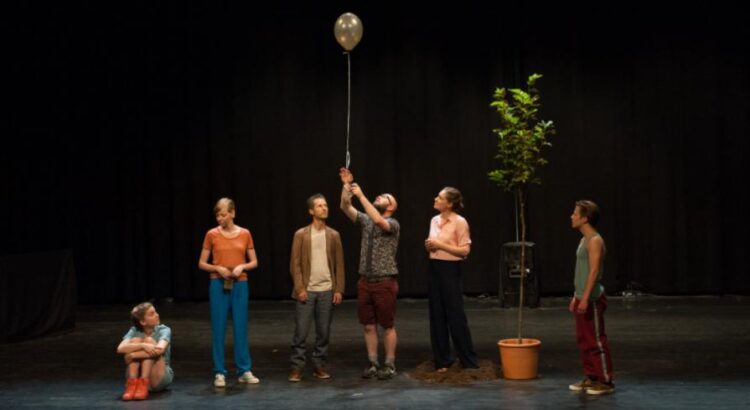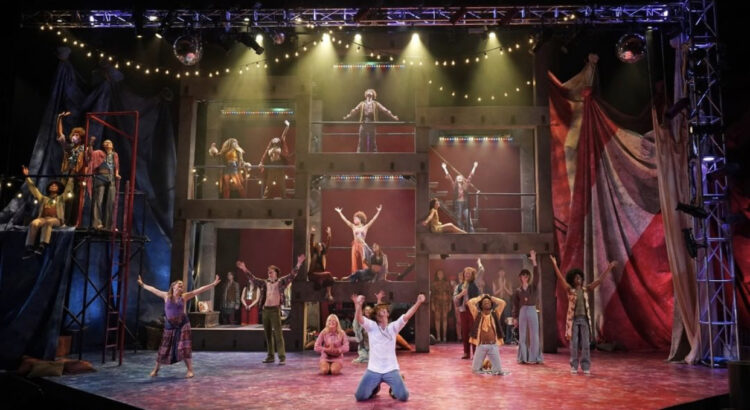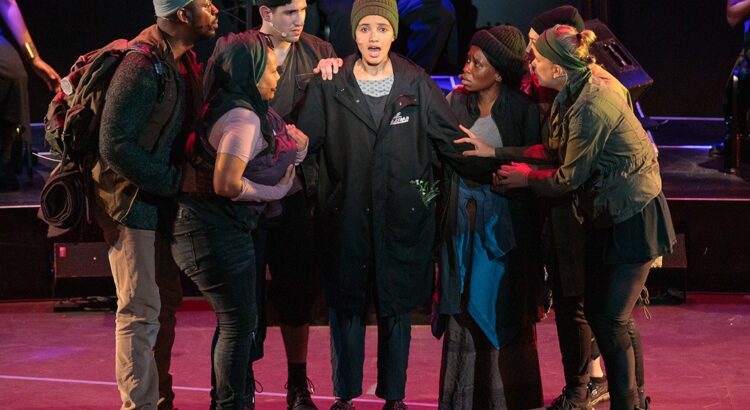**featured image from Ontroerend Goed
8:00pm • Saturday, January 20, 2023 • Power Center
Are we not drawn onward to new erA was a unique experience, although perhaps not one I would be interesting in reliving. The performance, by Belgian arts collective Ontroerend Goed, took place over the course of 75 minutes, with no intermission, and the pace was slow. The story began with a woman waking up, accompanied on the stage by a live tree, with a solitary apple glued to one branch. Soon she was joined by a man, who spoke the first word of the play. For context, the whole first half of the play was narrated in gibberish that was actually backwards-English. Despite this technical fact, the first word sounded like “Eros,” a reference I’m certain was intentional. The man plucked and offered the apple to the woman.
From there, the other four actors were gradually introduced and began to tear the tree limb from limb. I heard several sighs and groans rise from the audience-members around me. That destruction complete, the cast set about littering the stage with technicolor plastic bags, erecting a monumental bronze statue of a man, and pumping the set full of fog, at which point the curtains closed. Against the closed curtains, one of the cast members appeared, speaking backwards for interminable minutes, finally repeating, “?olleH” She imitated a rewinding recording until the syllables were ordered in a way we understood: “Hello?”
Speaking forwards, she gave the audience a speech about how the world has been littered and polluted by the actions of humans, and how it might be impossible to reverse the damage we have done… But then in a moment evoking The Lorax‘s famous “Unless,” the curtains opened again to a projection of the stage on a sheer screen. From there, the audience watched as, minute by painstaking minute, a video played the whole performance in reverse and the cast cleaned up the mess they had created. Literally and figuratively, they dismantled the statue/status of Man onstage.
I was surprised by the notes of Voluntary Human Extinction brought out in the ending of the play. At one point, the actors even pantomime holding guns to one another’s heads. Eventually, all of the actors disappear voluntarily into the darkness of the wings, leaving the woman who started the play to linger, alone, returning to sleep beside the tree to be absorbed as the stage lights lower. This felt meaningful, because her character was both the one who ate the apple in the first scene, symbolizing the “leap” humanity made towards corruption, and the one who advocated most fervently against cleaning up the stage or leaving Earth entirely. I feel that she strove to make the point that there is beauty in living, despite the harmful side-effects of human existence.
Overall, I would say that I enjoyed the performance, but it was so long. On the plus side, I had an extended built-in opportunity to ruminate on the meaning of the play’s palindrome structure. Is it realistic to compare the reversal of centuries worth of environmental degradation to a physics-defying rewinded video? Perhaps this was part of the goal of the work: to force the audience to take a break from their daily lives long enough to engage deeply with the climate crisis.









